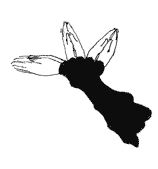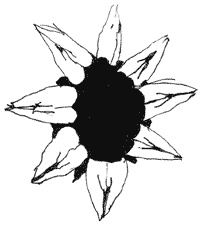 |
||||||||||||||||||||||||||||||||||
FRAGMENTED FIGURE
|
||||||||||||||||||||||||||||||||||
| |
||||||||||||||||||||||||||||||||||
Claire Curneen Exhibited Works cont. |
||||||||||||||||||||||||||||||||||
The insertion of items through the boundary of the body’s surface may suggest interiority but corporeality is attributed only within the construct of the figures’ religious narrative. They are too delicate, too frail to be of mortal flesh. They embody the divine. The only hint at any self–determination is given on occasions where the tips of their fingers have been dipped in gold, demonstrating that they have touched their wounds and responded to their fate. The body in Curneen’s work, the skin in particular, prompts more metaphoric than biological consideration, understanding the skin as, what Serres terms, a milieu, a place onto which we project our identities, societal, gendered and cultural thoughts2.
The titles and reference to Catholic martyrs and Saints encourage us to traverse between material and spiritual interpretation3. In ‘Crown’, for example, ceramic’s alchemic properties, its transformation from liquid to solid through evaporation and firing, can be seen in reference to aspects of transubstantiation. The clay conveys bodily conditions of blood and flesh and at the same time finds connection to a wholly other value system through their material worth as porcelain and gold. Our understanding of Curneen’s work is conditioned by this transference of properties, the projection of states from one reality to another. The wider beliefs of Catholicism extend the figures’ individual narratives. The assertion that the corporeal body is in itself incomplete, merely a temporal materialization of a larger, all encompassing whole, in God, renders their body already broken, fragmented before their wounds. The belief that the bread and wine of communion, becomes, rather than merely symbolizes the blood and body of Christ, affirms this perception of altered corporality, that through the act of swallowing, our body is, albeit temporarily or in part, bought closer to completion, returning and finding absolution. Notes2. Serres, M., Les Cinq Sens, Paris 1998, p. 59 back to text 3. For a more comprehensive account of Catholic and other Martyrs see J., Foxe, Foxe's Book of Martyrs, ed., W. B. Fobush, Whitaker House, 1981back to text
|
|
Sketchbook imagery, 2005 Composition for Crown, ceramic work completed 2005, approx. 30cm, porcelain and gold lustre
|
||||||||||||||||||||||||||||||||
| |
||||||||||||||||||||||||||||||||||
| University of Wales Intitute, cardiff | Adorfa Prifysgol Cymru, Caerdydd | ||||||||||||||||||||||||||||||||||
| |
|
|
|
|
|
|
|
|
|
|
||||||||||||||||||||||||



